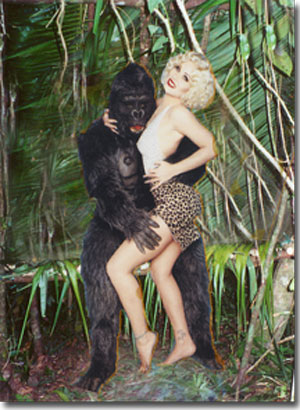
©2004, UrbisMedia
Fay Wray died this past week. In case you don’t remember Fay, here’s a hint: she outlived King Kong by seventy-one years. Wray is the actress who is immortalized as the screaming blond beauty over whom the giant ape went “ape” in the 1993 version of King Kong . It’s a classic of American film, which is why Fay Wray is remembered almost exclusively for her role as the object of Kong’s infatuation although she acted nearly one-hundred films. The actress was quoted in 1963 that “I used to resent King Kong. But now I don’t fight it anymore. I realize that it is a classic, and I am pleased to be associated with it.
Kong, wrenched from his far away island to the island of Manhattan to be displayed for the amusement of sybaritic New Yorkers was really smitten by Ann Darrow (Wray). So he breaks loose, crunches some cars, plays with the elevated trains, apprehends Ann and takes her to the top of the Empire State building. (No, he couldn’t have seen Sleepless in Seattle ; it wasn’t even made then). In the last Kong scene succumbs to the bullets of the warplanes, sets Ann gently down, and plunges to the street below. The showman who brought him there, played by Robert Armstrong, intones by his lifeless body the line that is supposed to sum up the poor creature’s fate: “Oh no, it wasn’t the airplanes. It was beauty killed the beast.”
In actuality the beast was only an eighteen inch high model for stop-action animation; one of the reasons the movie earned its “classic” status. Only one arm was “life (over) sized,” with a huge hand that caressed and even groped Ms Wray. (Oh, yeah; check that scene by the waterfall.)
But King Kong became a classic for several reasons. First, it was in the incipient genre of films, begun in part by Frankenstein two years earlier, that questioned man’s changing relationship to Nature, a theme that continues right up to Jaws , Godzilla, and Jurassic Park . The new technologies of the 20 th Century fed human hubris, and beneath the pure entertainment value of a titillating story about an ape and a blond girl, there lurked in movie audiences wonder about whether we had lost our respect for the power of Nature. In Kong’s case Nature loses out to technology.
RKO reprised the theme in 1949 with Mighty Joe Young . This time the big ape’s weakness is for actress Terry Moore, but the relationship closer to that of a blonde girl and her dog than Kong’s ardor. Mighty Joe gets hauled off to the city, too, but escapes and returns with his girl and her new cowboy-friend to his home jungle. Kong, who would never permit any such male competition turns up again in the Dino Di Laurentis remake (1976) with blonde Jessica Lang as the object of his desires. Same result though.
But is all this romantic pursuit just in one direction? Could another reason that King Kong is a classic be that it influenced a generation of blonde women primatologists? So far the best-known blonde to go chasing apes was in Gorillas in the Mist (1988) the story of primatologist and ill-fated gorilla activist, Diane Fossey. Film critic Pauline Kael called it a “ . . . feminist version of King Kong.” There are others, but perhaps the most renowned student of the species is once blonde Jane Goodall, who has lived and worked among her troops of chimps for decades.
If so, then Fay Wray really started something. No, I don’t mean all the jokes about apes and blondes, but the interest of many women in the study of primates. The likely explanation is just that women are probably more sensitive, patient, and less threatening to approach and build relation ships with our nearest simian relatives.\
But could it be that being a blonde is an added advantage?
___________________________________
©2004, James A. Clapp (UrbisMedia Ltd. Pub. 8.13.2004)
OK, I wasn’t trying to be offensive or sexist with this piece or the visual. So, if you are comfortable with that you can handle my favorite Blonde and Ape joke. It goes like this: A young blonde woman trekking in the highlands of Africa is abducted by a large male ape. After several months in his captivity she awakes one day and the ape is gone. She escapes to civilization, and because of her physical condition is hospitalized. Her mother comes to visit her in the hospital and says, “Oh, my dear we are so happy to have you back safe. I can’t imagine what you have gone through. You must feel just awful.”
The girl looks up, tears in her eyes, and replies: “Of course I feel awful, mother; he doesn’t call, he doesn’t write, he doesn’t text . . . .
